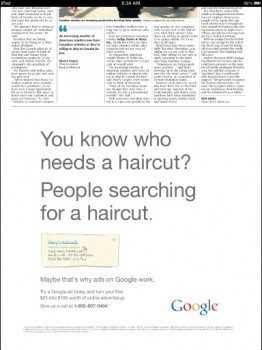
Who needs an Android phone? People searching for an Android phone
Google recently placed a tongue-in-cheek print ad in Canada’s Globe and Mail with a simple message. It asked, “you know who needs a haircut?,” and answered, “people searching for a haircut.” While the message here is that Google’s web ads are a more efficient and targeted way to market your business (not to mention an ironic jab at what some say is a dying print media industry), it got us thinking about the ways people are learning about products such as smartphones and subsequently making purchasing decisions.
In the past those looking for a new mobile device had one option: go directly to the carrier and pick from a small selection of devices locked to their network. While carrier contracts still rule the mobile world, recent years have seen an explosion in the number of third-party retailers offering to set you up with a new phone. Instead of walking into a carrier-branded store and choosing from a few handsets, we can now surf Amazon from the comfort of our homes and compare smartphones across carriers, ultimately picking the device and service plan that makes the most sense (often at price cheaper than what you might pay Verizon or AT&T directly).
It’s not quite what Google envisioned when they attempted to turn the mobile market on its head with the introduction of the Nexus One, at first available only as an unlocked device sold at full price direct from the tech giant, but it’s a move in the right direction. A lack of customer support and inexperience in the area led Google to abandon the plan, but more recently the company has had success selling their Nexus 7 tablet from the Google Play Store, and all signs point to the trend continuing with future Nexus devices.
There still exists a need for customers to experience these devices hands-on, so perhaps Google’s internet-only sales policy still needs some tweaking. Then again, there are plenty of folks out there relying on the opinions and reviews of industry experts and bloggers that often get early access and hands-on time with devices. An unboxing video doesn’t give you a real feel for that Nexus 7 you are thinking about purchasing, but for some it is enough. In this respect, carrier stores won’t be going anywhere anytime soon, nor will retailers such as RadioShack and Best Buy that offer the same hands-on experience with a wider selection of handsets.
I suppose the point I am arriving at is that customers are far more empowered today in making a decision on their next smartphone than ever before. No longer must you settle for the Android phone your preferred carrier sells. The choices have been expanded, phone and tablet options are plentiful, and deals abound if you know where to look. The carriers and their service plans still lag behind in this way, but if you are searching for an Android phone, you can find the best one for you.
Aside from the retail level there is an entire culture that has sprung up around smartphones, and its roots are in the strong community of developers and enthusiasts, tech industry insiders and analysts, and the blogs and news sites we read on a daily basis. Not only do we have more options, but we are far better informed on these options than ever before. The start of your journey to purchase a new phone is just a Google search away.
So that brings me to my ultimate question: how has the way you shop for a phone today changed since perhaps you purchased your first Android phone? And do you think we’re moving in the right direction? Sound off below (the poll is multiple choice, so feel free to pick more than one option).
[polldaddy poll=6463649]